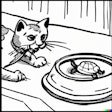
EDITOR'S NOTE: The journal article was retracted with the following notice:
"On behalf of my coauthors, I write to formally request a retraction to accurately respond to concerns expressed in the received Letters to the Editor regarding “Sixteen years of canine hepatic copper concentrations within normal reference ranges in dogs fed a broad range of commercial diets,” published online on March 7, 2024. Unfortunately, with further investigation, new data were discovered that materially change the results of the article as it reads today. The latest information revealed a change in reported liver copper concentration results imported from a portion of the 2006 to 2014–era sample. As a result of these findings, it is necessary to make corrections to uphold the integrity of scientific research and maintain the trust of our readers and the veterinary community. All coauthors agree with the retraction, with the full intention to resubmit and share the full results of this meaningful study in a timely manner. We regret that these new findings were unavailable to the authors earlier and apologize to the readers and editors for any confusion. We look forward to the opportunity to share corrected data in the future."
The conversation about the role of pet food ingredients in copper-associated liver disease has been going on for years. A very small percentage of dogs accumulate excessive copper in the liver, resulting in copper storage disease, hepatitis and/or cirrhosis. Various factors have been suggested as causes, including genetics and pet food ingredients. The first observations of the copper-storage disease affected only Bedlington Terriers due to an autosomal recessive trait in the dogs’ DNA. However, case reports have since appeared involving other breeds, such as Labrador Retrievers. As the number of affected breeds grew, so did the range of proposed causes. A straight-forward explanation of these copper-storage problems remained elusive.
A research team with Hill’s Pet Nutrition set out to look for patterns in copper levels over time in dogs’s livers. They used a storehouse of data present in records from kennels of dogs involved in feeding trials.
“We have this really wonderful bio-archive of samples, because the dogs eat a little bit of everything,” Leslie Hancock, DVM, study co-author and director of clinical nutrition research at Hill's Pet Nutrition, told Petfood Industry. Her team published their results in the Journal of the American Veterinary Medical Association.
Data from dogs eating varied diets
The dogs in Hill’s feeding trials eat a wide range of recipes during various palatability and digestibility studies. Because of this, the results were less influenced by any specific brand’s or recipe’s formulation and supply chain when compared to pet dogs that tend to eat the same varieties consistently.
“We're testing Hills products, we're testing competitors’ products, and we're testing global products,” she said. “Canned, dry, fresh, the gamut.”
The feeding trial dogs have eaten a far wider range of products and formulations than most dogs do in private households. That provided Hancock’s team with an uncommon opportunity to look for correlations among copper levels in dogs’ bodies and diet.
“If there were something endemic with an ingredient source or levels in dog foods since the dogs were getting this broad range, maybe we'll pick up trends in the dogs’ biomarkers,” she said. “If nothing else, it can serve as a baseline.
Previous studies mostly relied on liver biopsies taken for a specific reason, she said, but data was lacking about copper levels in the overall population.
Fluctuations in copper levels but no explanations
After analyzing the 336 samples taken during necropsies conducted from 2006 through 2022, Hancock’s team didn’t note any clear correlations between copper levels in dogs’ livers and their varied diets. Instead, copper concentrations decreased in dogs’ livers from 2006 through 2011, increased in 2012, decreased in 2013, and peaked in 2016, then began an ongoing decrease. Nothing related to ingredients or manufacturing stood out as a direct cause of those fluctuations, though.
There was a peak in one year, but it was not clinically relevant, Madison Amundson, associate scientist at Hill's Pet Nutrition and study co-author, said. Copper-levels in the dogs never fell outside of a normal reference range.
Considering genetics, Labrador Retrievers had lower liver copper concentrations compared to Beagles, while mixed breeds did not differ significantly from either purebred. Nevertheless, all the dogs’ copper levels remained within a safe range, Amundson said.
While no explanation for copper-storage disease presented itself, it did blaze a trail into a rich source of data.
“Hill's bio-archive is a unique item to have as part of our facility,” Laura Smith Motsinger, PhD, study co-author and senior scientist with Hill’s said. “There's a lot of potential there. It contains biopsy samples, it contains blood, it contains canine and feline. There's a lot there that we haven't explored yet.”
This paper using liver samples from the bio-archive will open up a gateway for other ideation projects, she said.

















